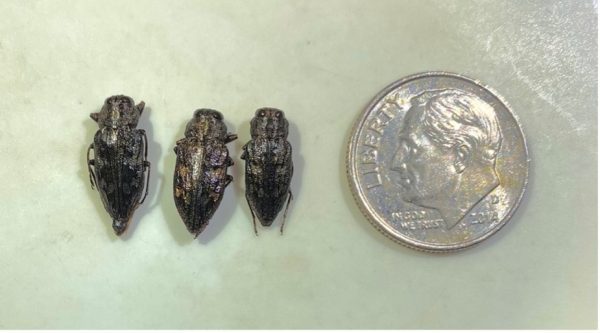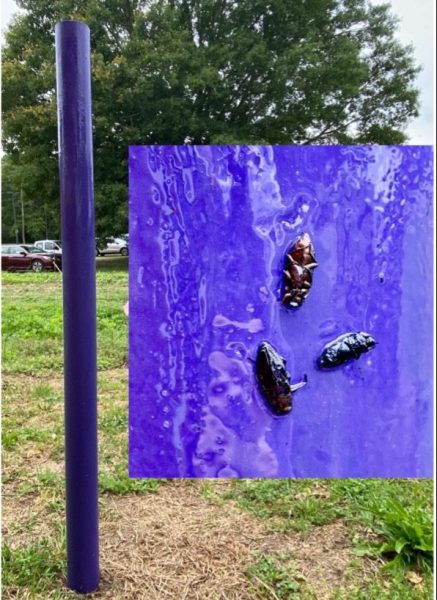Crop Production


Appearance and relative size of Chrysobothris femorata beetles. Many look-alike beetles and even some other borer species are similar in coloration and appearance but are much larger in size. For more information on wood borers, see ANR 2472.
The Flatheaded Appletree Borer (Chrysobothris femorata) and its close relatives are trunk and branch boring beetles. These are problematic pests of ornamentals (certain maple trees) and fruit (blueberries) or nut crops. The larval stage bores under bark, consumes soft wood tissues, and forms a gallery that can interrupt the vascular system of their host plants. In Alabama, the species distribution and seasonal activities are not well documented.
Since 2021, trapping surveys have been conducted during spring and summer for the adult beetles of flatheaded borers. In Auburn during April 2023, over 100 individuals were collected at the three trapping sites, which is about a 50-to-75 percent increase relative to previous years. This increase may pose a greater risk to susceptible crops this year than in previous years. Monitoring can use commercial or homemade purple sticky traps or poles. For this project, professionals made pole traps from painted PVC pipe.
Preparing a Pole Trap
Materials Needed

- 4 to 6 feet piece of PVC pipe (diameter is not important)
- Paint primer
- Exterior grade purple paint (our mix: Sherwin Williams custom color – N448-4x, gallon, S1-0x-0, W1-1x-16, M1-6x-12, B1-2x-8)
- Insect glue or trap adhesive. Insect glue can be purchased online at different suppliers including AlphaScents, Arbico Organics, ChemTica, Forestry Suppliers, Gemplers, and Trécé.
- Rebar or sturdy tree stake (sections that are 3- to 4-feet tall)
- Disposable gloves
Steps for Assembly
- Paint the poles, using at least one coat of primer and two coats of paint.
- Drive rebar or stake about 1 foot into the ground to hold the pole in place.
- If the glue is too thick to use a paint brush to apply it, wear gloves and scoop the insect glue into your hands and coat the pole. Do not use a putty knife as it will scrape the paint.
- Check the traps weekly for adult borers.
- To remove old insect glue, take a long piece of string, wrap it around the PVC, and begin to slowly pull down. Once some of the old glue is removed by repeating this process, more can be applied.
Send unknown insects to your local Extension office or the insect identification laboratory at Auburn University.
Prevention
Prevention of larvae invading a host plant is still the main way to prevent damage. Prevention is mainly achieved with insecticide treatments made to the bark (trunk sprays) or applications of imidacloprid, a systemic insecticide, applied to the soil in advance of infestations. Proper timing of trunk sprays requires monitoring with traps. Soil treatments with systemics can last multiple seasons but can be costly and labor intensive.
This work was supported by a grant from the National Institute of Food and Agriculture’s Specialty Crop Research Initiative grant program.

